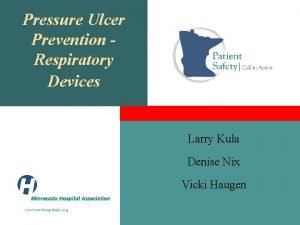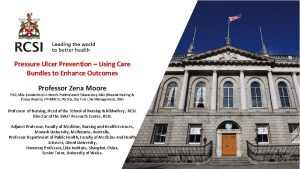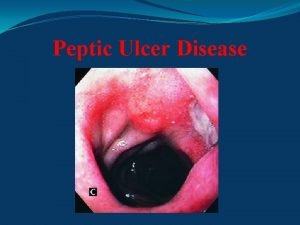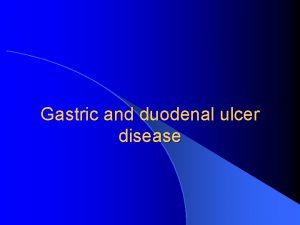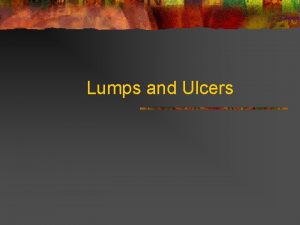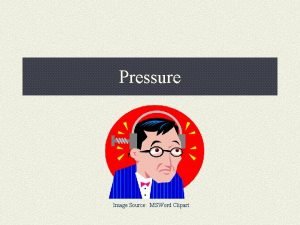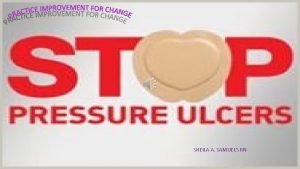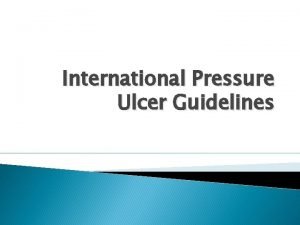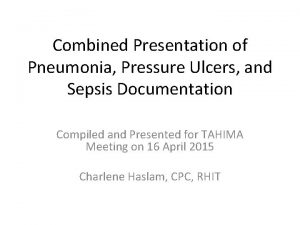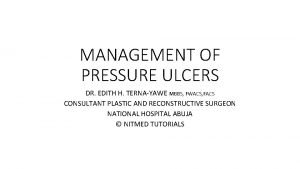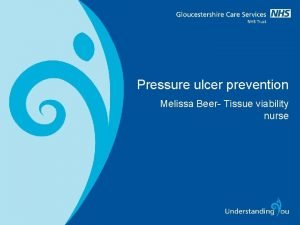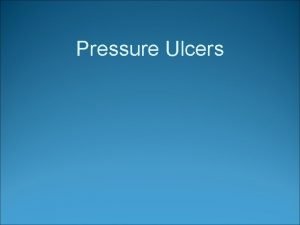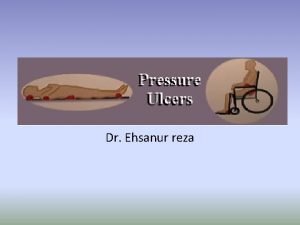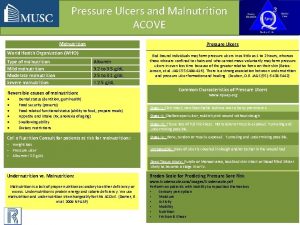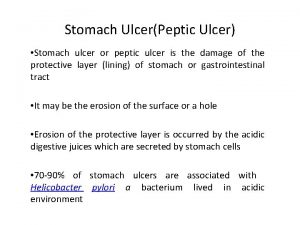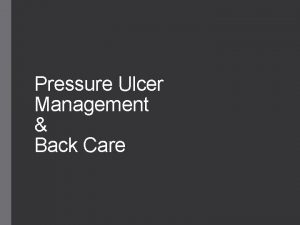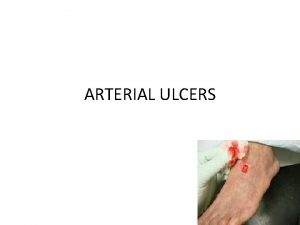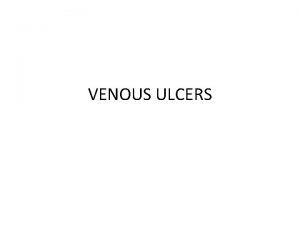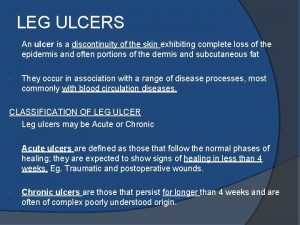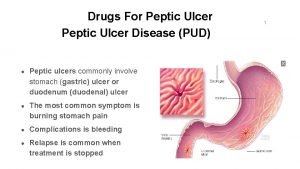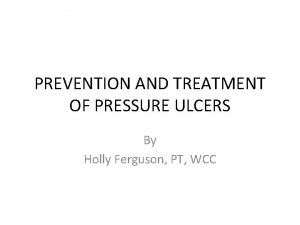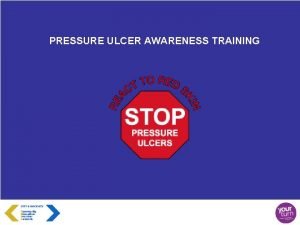PRESSURE ULCER AWARENESS Prevention Pressure Ulcers in the



































- Slides: 35

PRESSURE ULCER AWARENESS Prevention Pressure Ulcers in the Community

Introduction • Supported by the Public Health Agency this session is designed to increase awareness to help prevent avoidable pressure ulcers • By the end of this session we hope you will: • Understand what is meant by a pressure ulcer • Be able to identify who is at risk • State the most common causes of pressure ulcers • Identify the most common places on the body where pressure ulcers occur

The Frightening Statistics • In 2012 186, 617 people were reported as having pressure ulcers. Around 80 -90% of these were avoidable if preventative best practice had been followed. • Out of this figures approximately 1200 people died as a direct result of their pressure ulcer.

Overall Aims • To eliminate all avoidable stage 2, 3 and 4 pressure damage • Avoidable pressure ulcers are a key indicator of the quality of nursing care • Preventing them will improve all care for vulnerable people.

Why Carers Are Important • Care professionals have a key role to play in the prevention of pressure ulcers • Care professionals look after those most at risk in our community • Carers are in an ideal position to impart information and basic prevention steps to – Those they care for – Family members of those they care for – Other professional involved in the care of that person

What Are Pressure Ulcers • Pressure ulcers are a type of injury that affects areas of the skin and the underlying tissue • They are caused when an area of skin is placed under pressure • They can vary in severity from patches of discoloured skin to open wounds exposing bone or muscle

Who Is At Risk? • The greatest risk is to those who are immobile or have limited mobility and are unable to change position • People unable to feel pain due to spinal cord injuries or neurological disorders • Diabetics and people with vascular disease • Elderly people in general are at greater risk because the skin is thinner, drier and less elastic and is therefore more fragile • Anyone who is incontinent • Anyone suffering from muscle spasms • Peoples whose skin suffers with excessive moisture or dryness • People with decreased mental awareness

How Pressure Ulcers Can Affect People’s Lives • They are painful • Can cause depression, anxiety and paranoia • Stop people taking part in activities • Possible hospital admission due to infection or for plastic surgery on wound • Can and do cause death

Providing You With Simple Tools • The Blanch Test – What is it? – How do you do it? – Try is for yourself and see the results of healthy skin

Providing You With Simple Tools • What else to look for: – Blisters – Discolouration of the skin (if the skin is hard or leathery it indicates tissue death and a severe pressure ulcer)

The Four Steps of Prevention • Step 1 - Awareness – Simple advice and knowledge that can improve the outcomes for the people you are caring for – Demonstrates a commitment and willingness to prevent pressure ulcers with simple techniques

The Four Steps of Prevention • Step 2 – Policy – A management led task – Agree a ‘Policy on Pressure Ulcer prevention’? – Publish the policy for all to see – Put it on your website – Tell relevant authorities about your proactivity in this area – Have escalation plans in place to refer to relevant professional e. g. nursing, G. P.

The Four Steps of Prevention • Step 3 – Using The New Tools • There are some new tools available to help – A pressure ulcer information leaflet – A pressure ulcer public poster – A staff poster – A pressure ulcer checklist – A pressure ulcer booklet – An At Risk card

The Four Steps of Prevention

The Four Steps of Prevention

The Four Steps of Prevention • Step 4 – Keep It Going – Pressure Ulcer Prevention needs to become part of your day to day lives – Get used to using the tools to help record the work that you are doing – Publish your pressure ulcer prevention policy on your website along with the Your Turn logo to show your commitment – Keep a log of how many days ‘Pressure Ulcer Free’ you are in your area and communicate it regularly to staff using the Safety Cross

SSKIN – The Five Basics • • • Sick or unwell Skin red or sore Keep moving Incontinent Nutrition – food and drink


Human Biology

Understanding Oxygen and Blood Flow • The human body needs oxygen to survive • Oxygen is carried in the blood supply • The blood supply also carries carbohydrates and amino acids • It removes carbon dioxide • All of this is needed for healthy metabolism

Oxygen Deprivation and the Skin • Skin deprived of oxygen will begin to die if the blood supply is cut off for more than a few hours

The Skin

What Causes Pressure Ulcers • Pressure ulcers are caused by pressure against the skin that prevents blood getting to the skin and underlying tissues. Other factors can make the skin vulnerable and contribute to the development of pressure ulcers: – Sustained pressure – Friction – Shear

Sustained Pressure • When your skin and underlying tissues are trapped between the bone and a surface such as a chair or bed • This kind of pressure tends to happen in areas that aren’t well padded with muscle or fat • The affected area starts to hurt and then feels numb

Friction • Friction is the resistance to motion • This can occur when a person is dragged (instead of being lifted) over a surface • Can occur between skin and mattress or skin and clothing • The resistance may be greater if the skin is moist • This results in damage to the top layer of skin

Shearing • Shearing occurs when two surfaces move in the opposite direction • E. g. when a bed is elevated at the head a person can slide down it. As the tailbone moves down, the skin over the bone may stay in place – pulling in the opposite direction • Shearing causes the blood vessels in the skin and muscle to tear • The skin is now more vulnerable to damage from sustained pressure

Exercise • Try this in the comfort of your own home – Lie on a hard surface on your back, side and front – each for 1 minute – Do you feel where you main pressure areas are? – Were they where you thought they would be? – Were there any that you wouldn’t have thought of?

Where Do Pressure Ulcers Develop?

Medication and Pressure Ulcers • Some medication can inadvertently increase the risk of a pressure ulcer if it reduces sensitivity to pain or pressure • Care plans should be clearly noted with details of sedatives or other medication being given in order that correct pressure area care is undertaken

Mental Illness and Pressure Ulcers People with sever mental health conditions such as schizophrenia or severe depression have an increased risk of pressure ulcers for a number of reasons: – Their diet tends to be poor – They often have other physical conditions such as diabetes or incontinence – They may neglect their personal hygiene making skin more vulnerable to injury – Some mental illnesses affect the nerves in the body such as MS, Parkinson’s and Alzheimer’s disease

Summary • The care professional has an important part to play in reducing the risks of people developing pressure ulcers • A good understanding of how pressure ulcers develop and client groups at risk means that care professionals are better equipped to: – Reduce the risks – Provide a better standard of care – Educate those you are caring for and others around them



Conclusion • Only by really working together can we stop pressure ulcers, and stop suffering • We are all responsible for our client's wellbeing • Please help us to prevent pressure ulcer occurring in the first place

Revision • By the end of this session we hope you will: • Understand what is meant by a pressure ulcer • Be able to identify who is at risk • State the most common causes of pressure ulcers • Identify the most common places on the body where pressure ulcers occur
 Pressure mapping for pressure ulcers
Pressure mapping for pressure ulcers Primary prevention secondary prevention tertiary prevention
Primary prevention secondary prevention tertiary prevention Nasal cannula pressure ulcer prevention
Nasal cannula pressure ulcer prevention Sskin bundle
Sskin bundle Gastric ulcer differential diagnosis
Gastric ulcer differential diagnosis Typhoid and tuberculous ulcer
Typhoid and tuberculous ulcer Duodenal ulcer vs gastric ulcer
Duodenal ulcer vs gastric ulcer Types of gastric ulcer
Types of gastric ulcer Niche on lesser curvature
Niche on lesser curvature Modified johnson classification for gastric ulcer
Modified johnson classification for gastric ulcer Peptic ulcer definition
Peptic ulcer definition Nsaids and ulcers
Nsaids and ulcers Ulcer edge
Ulcer edge Excessive acid production
Excessive acid production Fibrin cuff theory venous ulcers
Fibrin cuff theory venous ulcers Stomach ulcer symptoms
Stomach ulcer symptoms Privacy awareness and hipaa privacy training cvs answers
Privacy awareness and hipaa privacy training cvs answers Pressure ulcer safety cross template
Pressure ulcer safety cross template Why doesn't air pressure crush objects
Why doesn't air pressure crush objects Pressure ulcer pico question
Pressure ulcer pico question International pressure ulcer guidelines
International pressure ulcer guidelines Pressure ulcer query template
Pressure ulcer query template Sore grade
Sore grade Category 4 pressure ulcer
Category 4 pressure ulcer Ng-html
Ng-html Số nguyên là gì
Số nguyên là gì Tia chieu sa te
Tia chieu sa te Các châu lục và đại dương trên thế giới
Các châu lục và đại dương trên thế giới Thế nào là hệ số cao nhất
Thế nào là hệ số cao nhất Chụp phim tư thế worms-breton
Chụp phim tư thế worms-breton Sơ đồ cơ thể người
Sơ đồ cơ thể người Tư thế ngồi viết
Tư thế ngồi viết đặc điểm cơ thể của người tối cổ
đặc điểm cơ thể của người tối cổ Cái miệng xinh xinh thế chỉ nói điều hay thôi
Cái miệng xinh xinh thế chỉ nói điều hay thôi Mật thư tọa độ 5x5
Mật thư tọa độ 5x5 Bổ thể
Bổ thể


